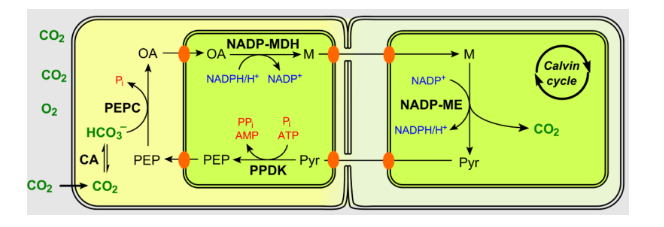
Describe the mechanism of Hatch and Slack pathway in $C_4$ plants?
Answer
432.3k+ views
Hint: HSK pathway is an important pathway for photosynthesis in \[C4\] plants. This pathway takes place in mesophyll cells which are present near the bundle sheath cells. Plants which are habituated in hot and dry climates adapt this type of pathway to save water loss. In this \[C4\] acid is broken to produce carbon dioxide and three carbon by-products.
Complete answer:
HSK pathway is adapted by the plants which belong to the tropical climate like sugarcane, sorghum. It occurs in the chloroplasts.
1)In this pathway, the primary acceptor of carbon dioxide is a three- carbon molecule called the phosphoenol pyruvate(PEP). This reaction converts ATP and Pi to AMP and PPi.
2)The fixation of carbon dioxide in \[C4\]plants is carried out by PEP carboxylase enzyme.
3)The PEP is converted to a 4-Carbon compound called the OxaloAcetic Acid in the mesophyll cells. This is not a stable product. It is converted into malic acid which is a 4-Carbon compound and is stable. It is transported to bundle sheath cells where it breaks into a 3-carbon compound and carbon dioxide.
5)The initial steps are carried out in the mesophyll cells whereas the cycle is completed in bundle sheath cells.
6)HSK pathway requires 30 ATP to synthesize one glucose molecule.

Note: HSK pathway takes place in the dark cycle of photosynthesis so as to prevent loss of water. It is an alternative to Calvin cycle. In the Calvin cycle the fixation of carbon dioxide takes place at one place whereas in HSK it happens at different places.
Complete answer:
HSK pathway is adapted by the plants which belong to the tropical climate like sugarcane, sorghum. It occurs in the chloroplasts.
1)In this pathway, the primary acceptor of carbon dioxide is a three- carbon molecule called the phosphoenol pyruvate(PEP). This reaction converts ATP and Pi to AMP and PPi.
2)The fixation of carbon dioxide in \[C4\]plants is carried out by PEP carboxylase enzyme.
3)The PEP is converted to a 4-Carbon compound called the OxaloAcetic Acid in the mesophyll cells. This is not a stable product. It is converted into malic acid which is a 4-Carbon compound and is stable. It is transported to bundle sheath cells where it breaks into a 3-carbon compound and carbon dioxide.
5)The initial steps are carried out in the mesophyll cells whereas the cycle is completed in bundle sheath cells.
6)HSK pathway requires 30 ATP to synthesize one glucose molecule.

Note: HSK pathway takes place in the dark cycle of photosynthesis so as to prevent loss of water. It is an alternative to Calvin cycle. In the Calvin cycle the fixation of carbon dioxide takes place at one place whereas in HSK it happens at different places.
Recently Updated Pages
Class 11 Question and Answer - Your Ultimate Solutions Guide

Master Class 11 English: Engaging Questions & Answers for Success

Master Class 11 Computer Science: Engaging Questions & Answers for Success

Master Class 11 Maths: Engaging Questions & Answers for Success

Master Class 11 Social Science: Engaging Questions & Answers for Success

Master Class 11 Economics: Engaging Questions & Answers for Success

Trending doubts
10 examples of friction in our daily life

What problem did Carter face when he reached the mummy class 11 english CBSE

Difference Between Prokaryotic Cells and Eukaryotic Cells

State and prove Bernoullis theorem class 11 physics CBSE

What organs are located on the left side of your body class 11 biology CBSE

Proton was discovered by A Thomson B Rutherford C Chadwick class 11 chemistry CBSE




